Natural Wonders
Hervey Bay is the departure point for tours going to Fraser Island. Steve and I arrived in Hervey Bay a day and a half early, and decided to occupy ourselves the way the locals do on the weekends: fishing.Steve and I went fishing together one other time, on a camping trip in Eastern Washington. That time, despite countless hours devoted to the pursuit, we caught nothing and barely even had any nibbles. This caused me to be less than confident about catching anything this time, but an afternoon sitting on a sunny dock is enjoyable even without any fishy companions.
We rented our fishing poles for a 24-hour period, which meant we fished late one afternoon, and most of the next day. The man at the bait store, Mick, was very nice and helpful, and hooked up our tackle for us. He had a very obvious and unfortunate comb-over, which distracted me while he told Steve the best times of day to fish and gave us a free tide table.
The pier in Torquay (the section in Hervey Bay where we were staying) is one-and-a-half kilometers long - about a mile. It is specifically for fishing, and there are rod holders on the railing all the way down the pier. It is so long because during low tide, there is only water at the end.
We lugged our rods, tackle box and frozen squid (bait) onto the pier and spent a few hours catching nothing. Eventually, we got hungry and left to get dinner. Steve was very excited about fishing, so the next morning, he got up early and drove the van (with me sleeping in the back) to the pier and did more fishing. When I finally awoke and joined him with breakfast, he told me he had caught three small toadfish - fish that are poisonous to eat and make a weird croaking noise when caught. They had been thrown back.
After an internet break mid-day, we returned to the pier. The day before, we had both gotten our hands dirty and baited our own hooks with the squid. We found that it left a smell that was hard to get rid of - so the second day, Steve offered to bait all the hooks so that one of us would have clean hands. And we fished.
And the fish bit! It wasn't long before I caught my first fish - too small to keep, but exciting nonetheless. Steve took a picture of me gingerly holding the fish. We then devised a contest - the winner (of a $10 bet) would be whoever caught the most fish, defined by a fish that is brought up to the pier, regardless of size. And we spent the whole afternoon fishing. At some times, a fish would bite as soon as I cast out my line. At first, Steve and I were neck-and-neck, but my luck just kept going and I ended up catching 35 fish - not one large enough to keep, though. Steve caught 15.

|

|

|
Despite Mick's advice, we fished at low tide instead of high tide. When the tide finally came in, the pier filled with anglers and most of the rod holders were filled. But after that, the fish stopped biting my hook and I didn't see many other people catching fish, either. (One notable exception was a man who drug in a meter-long catfish right in front of us.) We felt like we had beaten everyone to the fish. It was a fun afternoon.
~ * ~ When we heard there was a turtle rookery and research station on our way, Steve was excited to visit. He had volunteered at a sea turtle research station in Costa Rica a year ago and was keen to revisit those memories. The place, Mon Repos, was open at 7pm at night, since turtles are only onshore in the dark. This time of year, most of the egg laying is finished, and turtles were beginning to hatch.
We payed our admission fee, and were directed to wait. Researchers (volunteers) patrolled the beach looking for action, then they radioed to the visitor center and tourists were led to the beach in groups. We were warned the wait could be hours. After maybe 20 minutes, a researcher took Steve and I and three others down the dark beach to a nest that had recently hatched. She was planning to dig up and count the eggs in the nest, but when we arrived, more hatchlings were struggling up through the sand.
This nest still had maybe 40 hatchlings still on the way out, each a tiny turtle about the size of a plum with legs. The researcher picked one up and held it out for us to examine and touch. It had a nice leathery feel, both on its shell and skin. It waved its legs (fins, really) constantly, as instinct dictated. Its legs were strong for something so small, and had tiny claws.
When turtles hatch, they wait below the sand for the temperature to drop, which means it is night. Suddenly one will break for the surface, and the whole nestfull follows. They instinctively head toward the lowest light in the sky, which is almost always toward the sea. The researchers temporarily put the hatchlings in a little cage while others emerged from the nest. This was so we could watch all of them struggle down the beach to the sea, and make sure they were safe. When it was time, we stood in a line and watched the tiny creatures scramble their way down the sand and into the surf.
We had not been allowed to hold the hatchlings. I'm not sure exactly why, but it made enough sense. However, just as we were returning to the visitor center, a researcher asked for everyone's help. Two nests of hatchlings were trying to get to the sea over some rocks and a few had been caught by crabs. Everyone pitched in and picked up little turtles in handfuls of two and three. We put them in a bag and released them, over a hundred, safely into the sea.
~ * ~ For us, the highlight of "World Heritage listed" Fraser Island was Lake Mackenzie. The island has many lakes, but this one is unique: it is above sea level, and it is filled solely by rainwater. Since it has no creeks or rivers or other kind of connection with other water, there are no fish living in it. The only inhabitants are a few turtles (which we didn't see). These factors combine to make this an extremely pure lake. The water tasted like it came from a bottle - no lakey flavour. It left our hair silky and soft, as well.
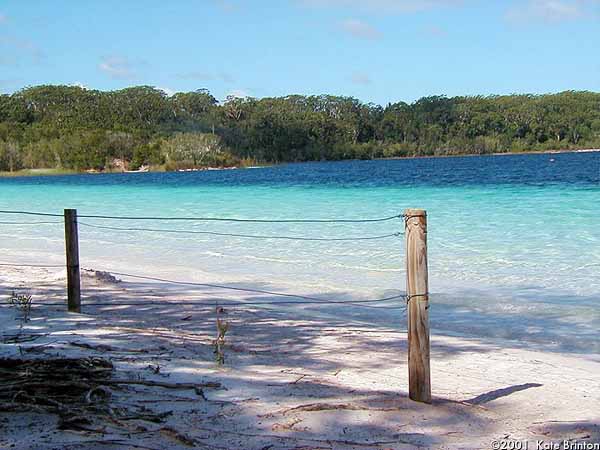
The sand is also exceptional. All of Fraser Island is made of sand, but the sand in Lake Mackenzie is much older than other parts of the island. This means that the grains are very small and rounded, and amazingly enough, work beautifully as silver polish. When our guide told us about this, we were doubtful, but I took a handful of sand from the bottom and rubbed it on my rings anyway. To my surprise, it made them gleam!
Our group had so much fun splashing around and playing in Lake Mackenzie that our guide took us on a second unscheduled visit on our last day. My hair felt soft for days afterwards.
Here are some more pictures from Fraser Island:
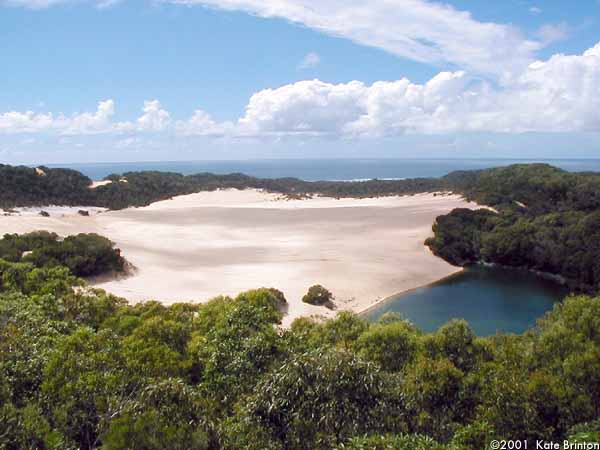
Lake Wabby, being slowly covered by sand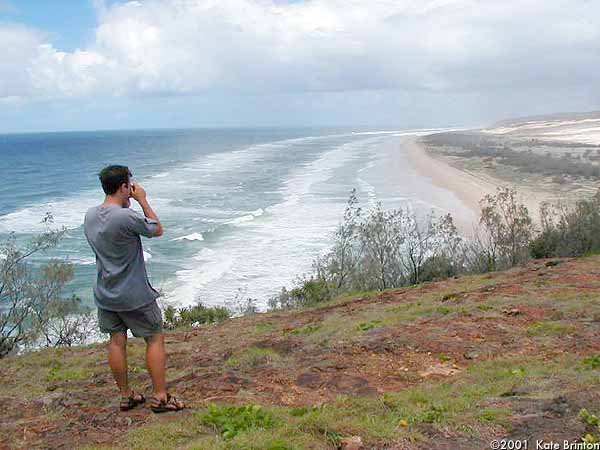
Indian Head, a big rock bluff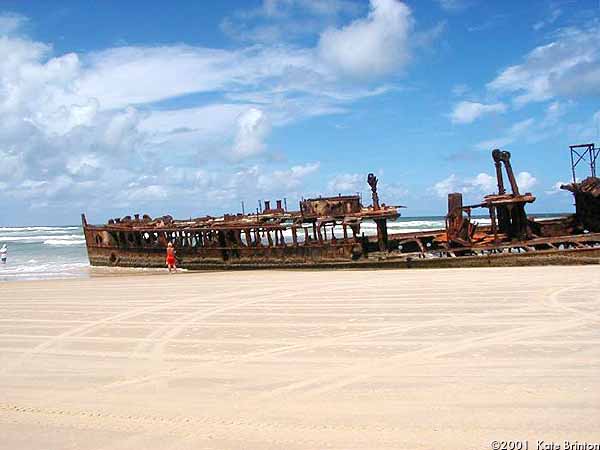
A shipwreck ~ the Maheno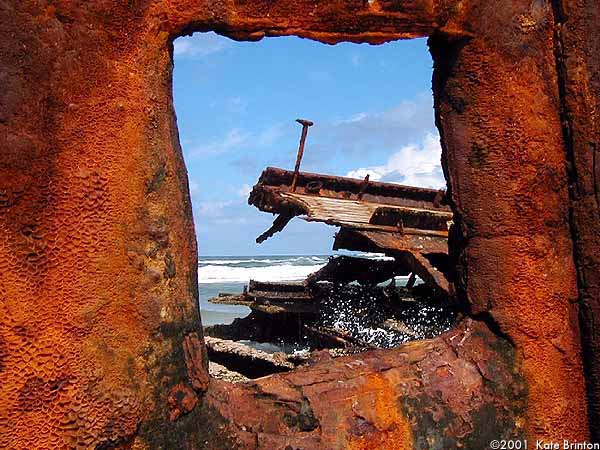
The Maheno up close
The island is made entirely of sand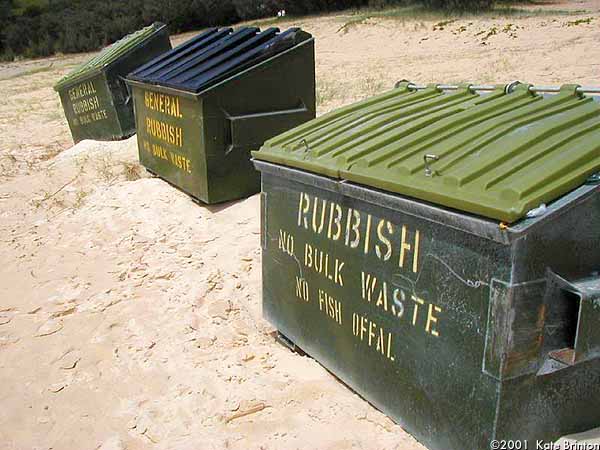
The dumpsters have to go somewhere
~ * ~ We just missed a cyclone yesterday. A cyclone is a hurricane that turns in the opposite direction... so all such storms are cyclones in the Southern Hemisphere. It began as a tropical depression by the Great Barrier Reef, then solidified into Cyclone Abigail and headed for Cairns at the same time as we did.
Despite some practical concerns, I was excited to see the cyclone because I love storms. But unfortunately (and fortunately, too, I suppose), we spent an unplanned day in an armpit of a town further south because of a mechanical problem with our campervan. The town was so backward that most of its shops and the police station were closed (on a Saturday), there was no internet access, and nobody who was open had a radio. So when our van refused to start, we had no way to get news about the cyclone.
By the time we got started again and arrived in Cairns, Abigail had disintegrated back into a tropical depression and headed inland. The only proof of her existence was some torrential rain she left in her wake.


